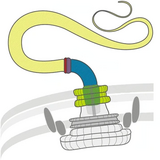| Part of a series on |
| Microbial and microbot movement |
|---|
 |
| Microswimmers |
| Molecular motors |
Run-and-tumble motion is a movement pattern exhibited by certain bacteria and other microscopic agents. It consists of an alternating sequence of "runs" and "tumbles": during a run, the agent propels itself in a fixed (or slowly varying) direction, and during a tumble, it remains stationary while it reorients itself in preparation for the next run.[1]
The tumbling is erratic or "random" in the sense of a stochastic process—that is, the new direction is sampled from a probability density function, which may depend on the organism's local environment (e.g., chemical gradients). The duration of a run is usually random in the same sense. An example is wild-type E. coli in a dilute aqueous medium, for which the run duration is exponentially distributed with a mean of about 1 second.[1]
Run-and-tumble motion forms the basis of certain mathematical models of self-propelled particles, in which case the particles themselves may be called run-and-tumble particles.[2]